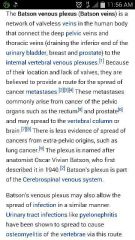![]()
![]()
![]()
Use LEFT and RIGHT arrow keys to navigate between flashcards;
Use UP and DOWN arrow keys to flip the card;
H to show hint;
A reads text to speech;
9 Cards in this Set
- Front
- Back
|
Hip exam
|
Hip exam
1st : Look A) Front : symmetry , pelvic tilt , deformity , muscle wasting. B) Side : scar , increased lumbar lordosis C) Back : scoliosis , sinus , scar , muscle wasting 2nd : Length Look (flat on couch , knees flexed and heels together) Measure a) true length : ASIS to medial malleolus b) apparent length : Xiphisternum (or umbilicus) to medial malleolus. 3rd : Feel Femur head : anterior below the inguinal ligament just lateral to the femoral artery ASIS and iliac crest Greater trochanter Adductor longus (lesser trochanter) Hamstring origin (ischial tuberosity) 4th : Move Abduction , Adduction (making sure the pelvis is not moving by placing you thumb and middle finger on each ASIS), internal and external rotation , flexion. 5th : Special tests Trendelenburg test : hip support Thomas test : fixed flexion deformity Walking Neurologic exam X-rays |
|
|
Knee exam
|
fff
|
|
|
Shoulder exam
|
fff
|
|
|
What is Meralgia Paraesthetica ?
|
Meralgia Paraesthetica results from compression neuropathy of the lateral cutaneous nerve of thigh. It is also called Bernhardt-Roth syndrome. This nerve can be compressed as it runs through the inguinal ligament, just medial to the Anterior superior Iliac spine.
Pain, numbness, tingling and paresthesia localised to anterolateral aspect of thigh. Metabolic disorder most notably diabetes is identified as the potential cause of this condition. |
|
|
What is Allen’s test ?
|
Allen’s test allows assessment of the extent of connection between the radial and ulnar arteries through the palmar arches.
In Allen’s test: the examiner compresses both the radial and ulnar arteries at the wrist and then asks the patient to flex and extend the fingers repetitively. After the hand blanches, pressure from the radial artery is released while compression is maintained on the ulnar artery and the examiner observes how long it takes for each of the fingers to regain its pink color. The initial step is repeated with both vessels compressed, and the ulnar artery occlusion is then released while pressure is maintained on the radial artery. Again, examination of the reperfusion of the fingers reveals which digits are primarily supplied through the ulnar artery. |
|
|
What is Milkman's fracture ?
|
Milkman's fractures are pseudofractures (Looser's zones) seen at sites of mechanical stress or nutrient vessel entry that reflect areas of unmineralized woven bone.
|
|
|
What are the most common congenitally absent muscles ?
|
Pectoralis major and minor muscles are the most common congenitally absent muscles in humans.
|
|
|
What is triple arthrodesis ?
|
Triple arthrodesis results in fusion of subtalar, calcaneocuboid, and talonavicular joints. It is most effective procedure for fixed hindfoot and forefoot deformities. Triple arthrodesis tend to have a high (50%) failure rate in children under 10 years of age. Fusion of the above said bones is done after 12 years of age only because before that the bones are cartillagous.
|
|
|
How do cancers from bladder , breast spread to the spine and
|

|

